My video game collection (2015)
I've been interested in video games ever since I can remember. First I played them; then I collected them; then I programmed them. This article showcases my video game collection as of the end of 2015, as a result of about 15 years of collecting for various platforms (PC, home systems, arcade, etc.)

I did not build this collection single-handedly; benevolent contributors include friends and co-workers.
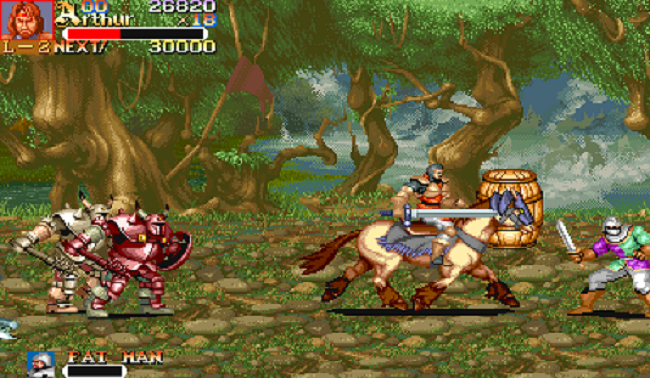

Knights of the Round is my favourite game of all time. I invested great amounts of time and money in the local arcade playing it, and I have many fond memories of it. Obtaining the original arcade board for my collection was a no-brainer. It is a classic arcade beat'em up set in Arthurian Britain.
I like this game so much, that I've written what some call a very in-depth review of it here. My review covers so many aspects (technical, gameplay, ports, exploits, etc.), that some called it a dissertation!


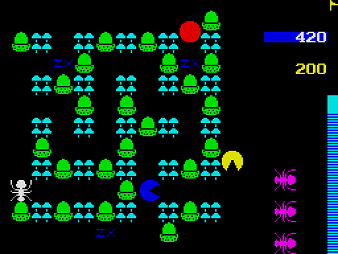
Hyperaction was the first video game I ever played, at around 4 years old, on a ZX Spectrum+ computer. I played it because my parents and uncle played it. Its difficulty would often frustrate me as a child. It's a single-screen puzzle game where you must collect all items while avoiding enemies, and then reach a "goal" square.
As with most ZX Spectrum games, it was distributed on a regular cassette tape. It took about 4 minutes to load from a cassette player.
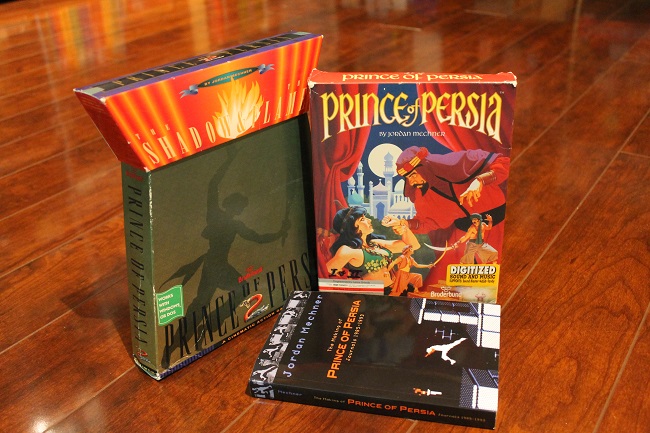
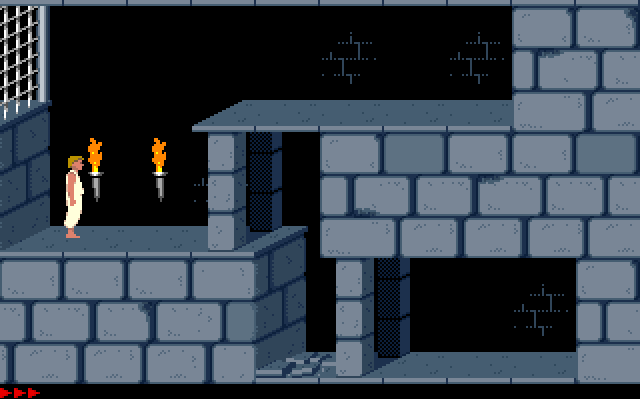
Here are Prince of Persia 1 and 2 for DOS. Prince of Persia 1 is the first game I played on the PC, having access to it on a computer at my father's work, in the early 90s. The life-like animation, dungeon and castle graphics, cinematic game play and story telling made this a master piece.
The book is a print publication of excerpts of Jordan Mechner's (the creator of the series) personal diary. It describes the creation of the first game, including struggles with red tape, financial negotiations, keeping up the sponsors' faith in the project, etc.
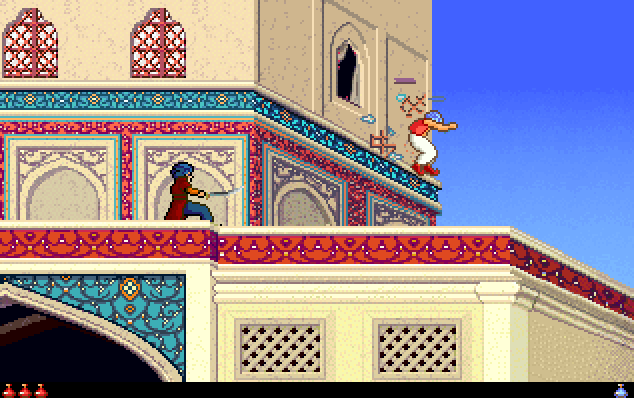
The second Prince of Persia came a few years later, taking up a hefty four floppy disks (about 12 times larger the original). Prince of Persia 2 had significantly improved visuals, with parts of the game taking place in caves, castle ruins, temples, etc. The difficulty was also cranked up.
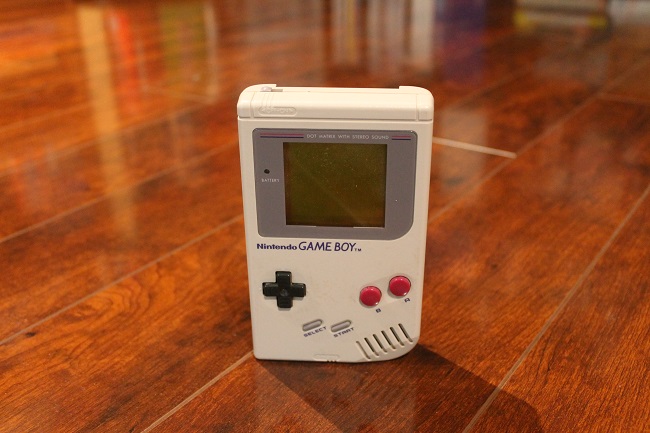
This is the first building block of my collection. It's how it all began. I bought it for between $10 and $15 in 2001.
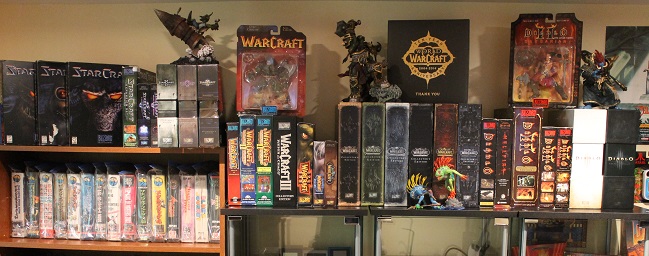
I focus on Blizzard's "big three" game series, Warcraft, Diablo, Starcraft. Collector's Editions are preferred over standard editions. Blizzard is known for its very high quality video games, which is probably why they've kept me as a faithful follower all these years.
The Starcraft section is on the left, the Warcraft games are in the centre, and to the right are the Diablo games.
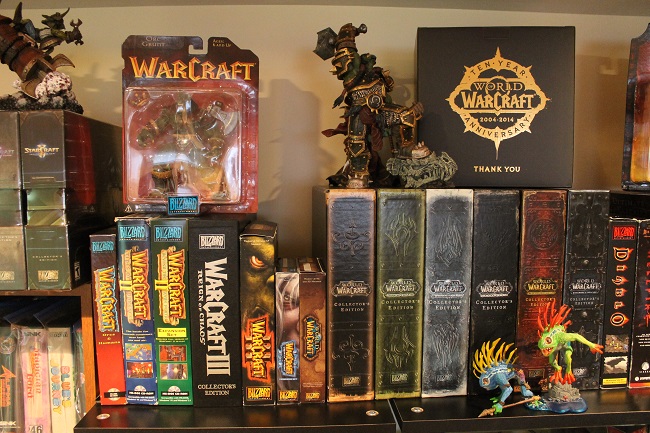
I was over at a classmate's, and he showed me Warcraft 1: Orcs and Humans. Seeing the little soldiers attack a building in unison (which later burns down and is destroyed), was awe-inspiring.
Since then, I continued to follow the Warcraft series of games.
The orc grunt action figure at the top left was sold when Warcraft 1 was current (1994), and the boxed World of Warcraft orc wolf rider statue in the centre was sent out in 2015 as a surprise to subscribers who had active accounts for throughout all 10 years from World of Warcraft's release.
It also coincided with the 20 year celebration of the Warcraft franchise.
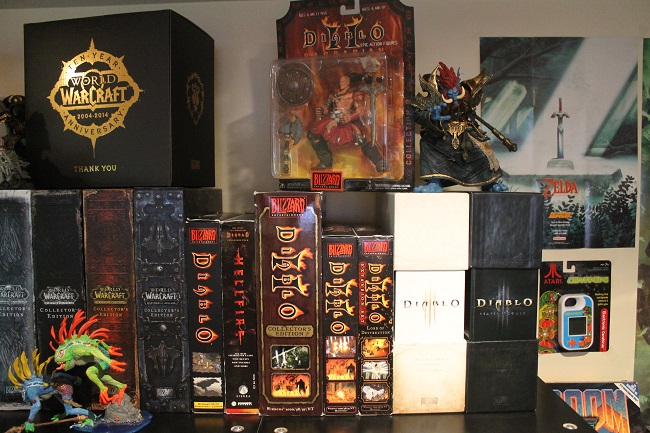
Similarly, I've stuck with the Diablo series because of how impressive dungeon and item randomization was to me when I first played Diablo 1.
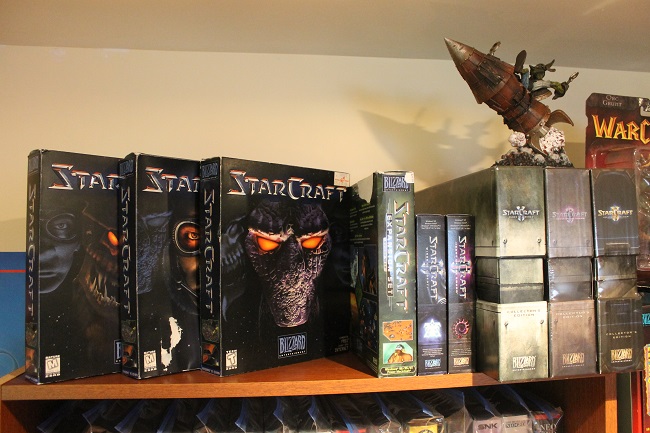
I played the Starcraft games the least, but I have great memories of playing it against my friends at early Internet Cafes in Bucharest.
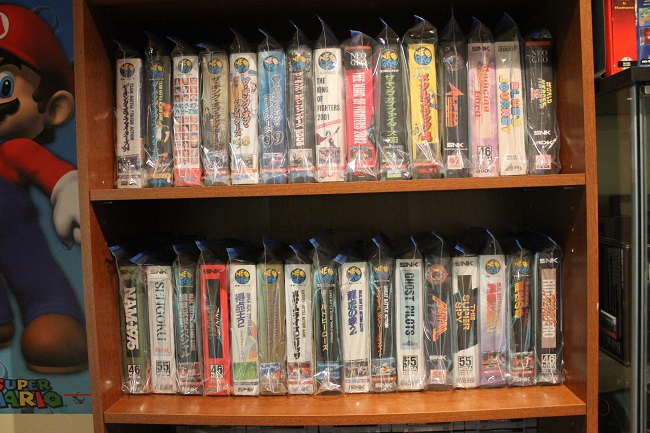
The Neo Geo was mostly known as an arcade platform, offering games such as King of Fighters, Samurai Shodown, Fatal Fury, World Heroes, Metal Slug, etc. I played these in an arcade in downtown Bucharest. Later, I discovered the Neo Geo AES, the home console which contained arcade hardware. This meant that it enabled 100% arcade-faithful game play in the home, unfortunately at a very high cost.
Noteworthy games in this collection are Metal Slug 4, and the complete King of Fighters series (10 games, released in 1994 through 2003).
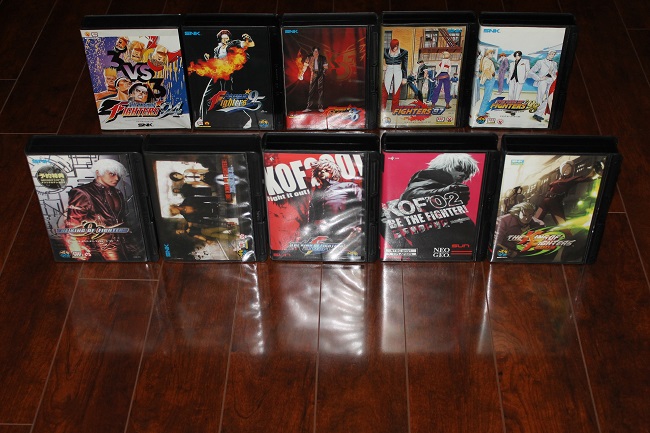
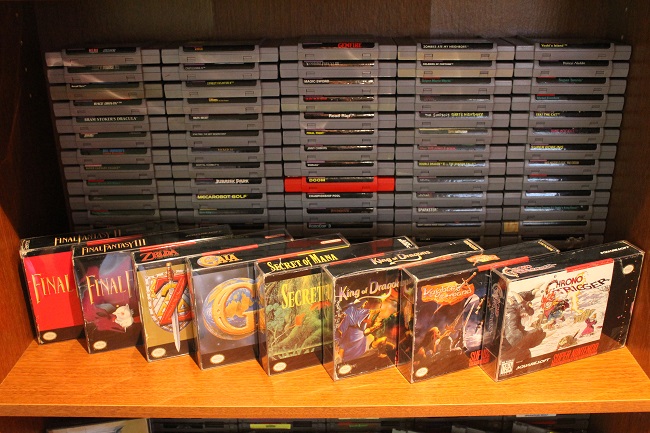
While the Neo Geo AES is my favourite home console, the Super Nintendo is undoubtedly the richest in games and genres. Along with the Neo Geo, I consider these games to be the highest quality two-dimensional (pre-3d) games ever produced.
Role playing games shine brightest on the Super Nintendo, which is why I like to collect them complete (with box, manuals, maps, etc.)

The Nintendo Entertainment System was a highly influential platform, which reversed the video game crash of the 1980s caused by gross disregard to quality by major players such as Atari. It is home to the start of successful franchises such as Super Mario Brothers, Zelda, Metroid, Mega Man, etc.
The Pokemon series began with these three titles (Pokemon Red, Yellow, and Blue) and went on to become an international phenomenon. Its creator collected insects as a hobby, which inspired the series.
I liked and bought the complete in box Zelda cartridge because of its historical importance and its nice gold colour. Gold is best.
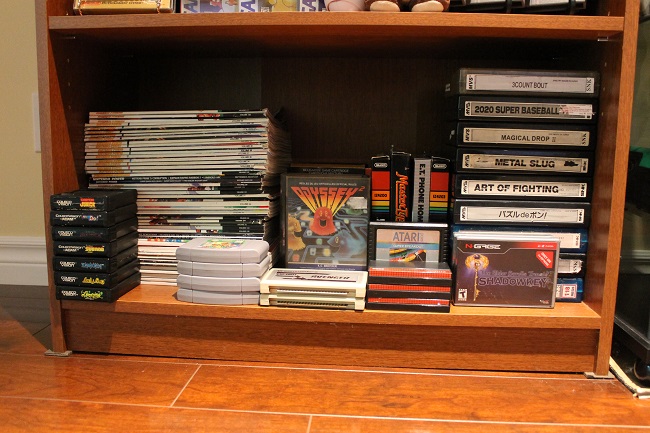
Nintendo Power magazine was the best source of video game information available in the 80s and 90s, due to the general absence of the Internet.
To the right, there is a stack of large Neo Geo MVS cartridges. These were used in Neo Geo arcade machines, especially the multi-game versions, which allowed the player to choose between multiple games. My first contact with Neo Geo games was in a large arcade in downtown Bucharest, where I played primarily King of Fighters 94.
The other cartridges here are for a variety of systems including Nintendo 64, Odyssey 2, Nokia Ngage, etc.
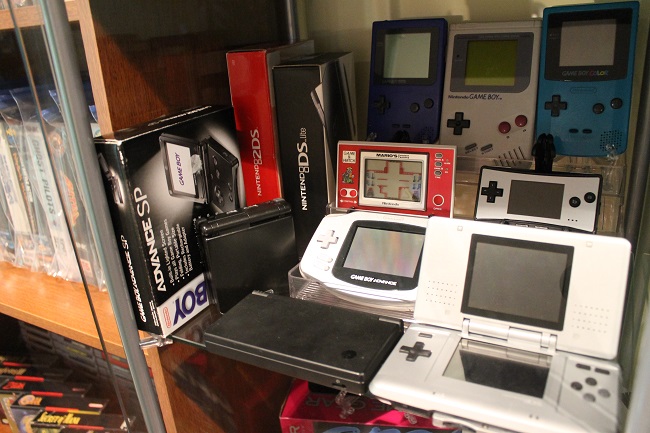
These hand helds here start with the Game and Watch LCD games of the 80s and go all the way to the 3DS/2DS platforms, Nintendo has been the dominant player in the hand held market despite fierce competition from Sega, Atari, Sony.
The Game and Watch LCD game here is Mario's Cement Factory, which a friend showed to me back in Romania. Nintendo LCD games were more feature-rich than abundant no-name LCD games from the early 90s.
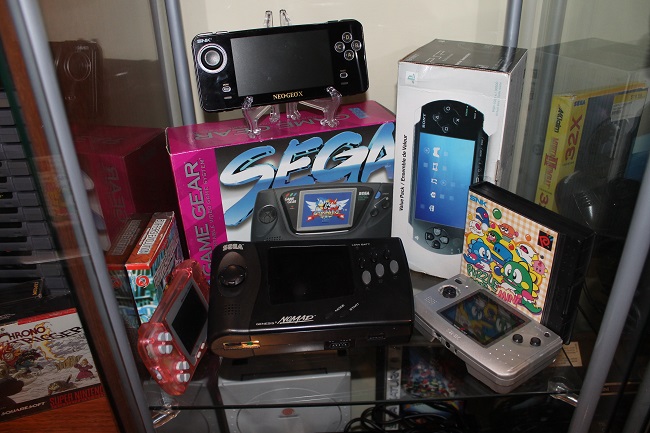
Here we have Sega Nomad, which plays full-size Sega Genesis cartridges, the controversial Neo Geo X, the WonderSwan, and the Neo Geo Pocket Color. To the right is a Sony PSP.
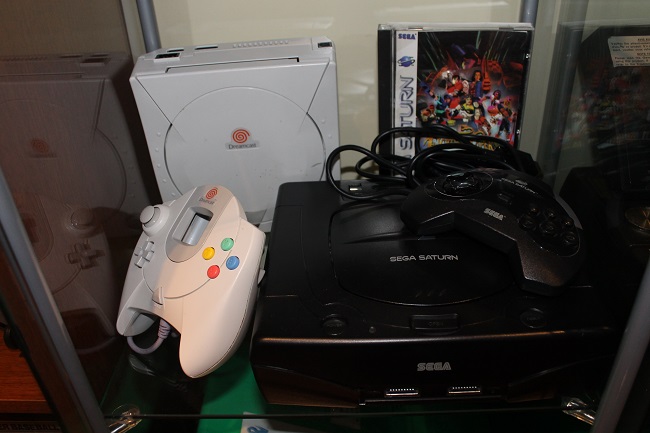
Sega's last two home systems. The Saturn was very popular in Japan, while the Dreamcast enjoyed success all over the world. The Dreamcast was home to many high-quality arcade games.
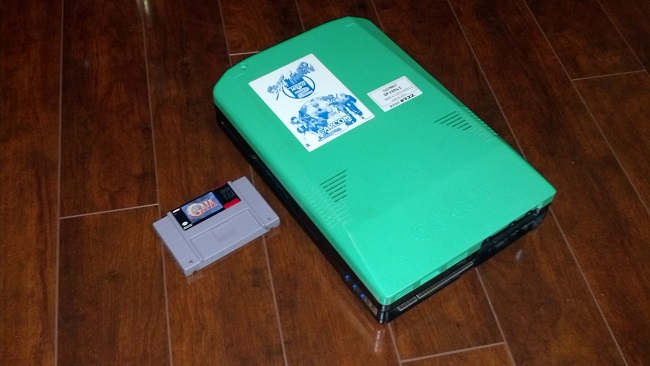
This huge green thing is actually two boards: the black motherboard at the bottom, and the green game "cartridge" on top. The game here is Street Fighter Zero 2, the Japanese version. These CPS2 boards were used in arcade machines of mid 90s to early 2000s. I used to play a similar CPS2 game, X-Men vs. Street Fighter at a pool hall which had arcade games in its basement, in Bucharest.
The SNES game cartridge is shown for size comparison.
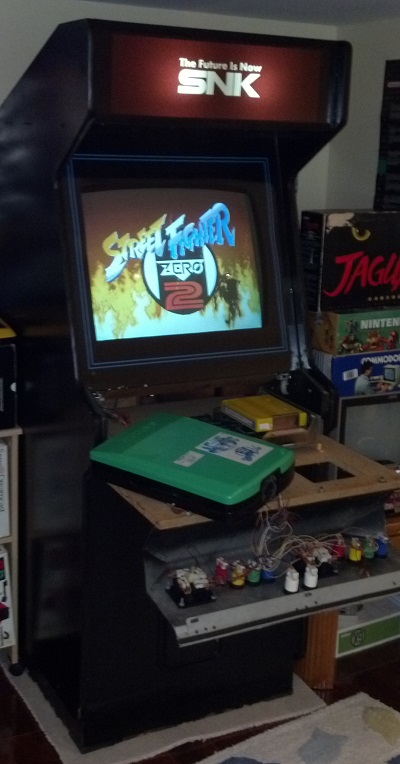
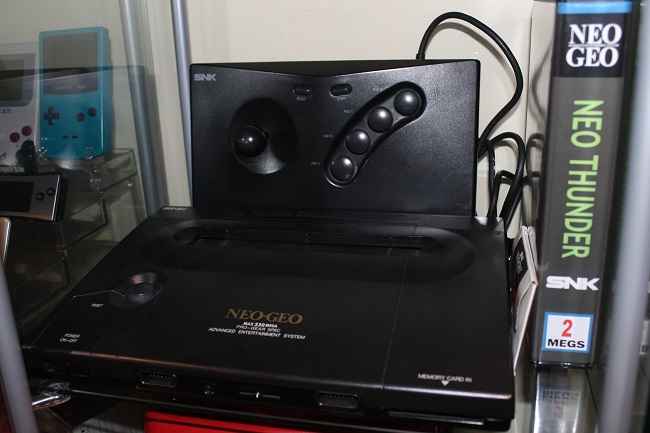
An elite console which brought arcade-perfect games (in a time when home games were much lower quality) into homes for the first time ever. A single game cartridge cost as much as a competitor's console. The Neo Geo AES was never meant to be mainstream; it targeted a niche segment of hardcore gamers with deep pockets.
The game is Neo Thunder, which I programmed myself.
The controller shown here is the arcade-style controller, which has a joystick and buttons arranged the same as the arcade machine.
It's noteworthy to mention that the Neo Geo AES was the first console to ever use memory cards. Game progress could be loaded and saved interchangeably between AES home systems and MVS arcade systems.
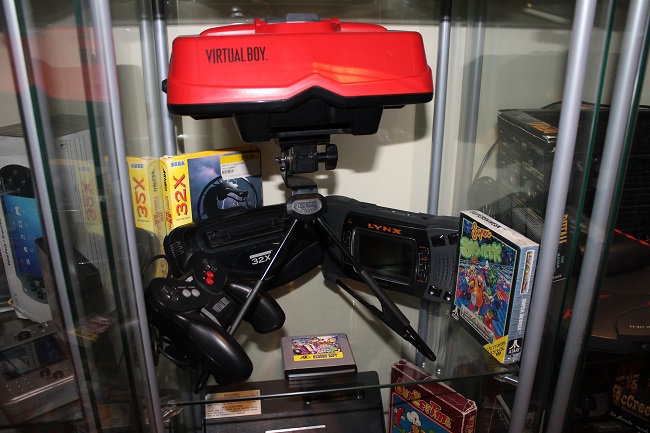
The Virtual Boy uses two displays, one for each eye, to successfully give the impression of 3d. It was Nintendo's biggest failure, causing headaches shortly after starting game play, and forcing
Nintendo to cover the manual in red-text health warning sections.
To the left there is the Sega 32x, meant to prolong Sega Genesis/Megadrive's life. To the right is the first ever colour hand held system, the Atari Lynx.

The Intellivision (complete with awesomely tasteless faux wood panels) was born out of Mattel's desire to benefit from the booming video game market.
The Gemini is an Atari 2600 clone created by Coleco. It is interesting because Coleco also created
the ColecoVision, meant to compete with the Atari 2600. In today's terms, this is analogous to Sony not only creating the PlayStation, but also creating an Xbox clone.
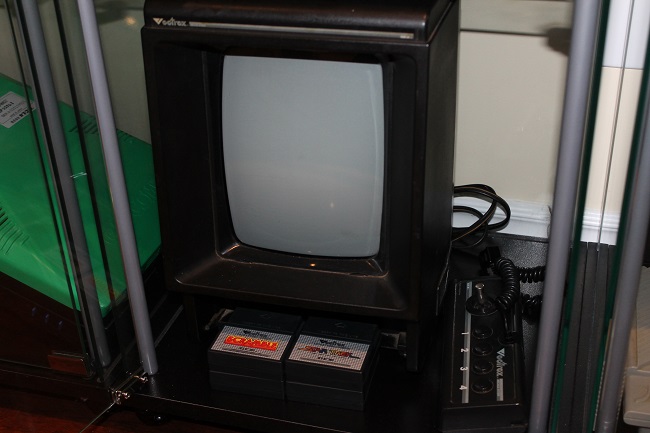
This system not only incorporated its own display, but was also vector-based rather than raster based. All graphics it output were made of (theoretically) infinite resolution lines. This made game play feel very smooth compared to traditional raster-based consoles.

Atari's alpha and omega, their first and last home consoles. The 2600 (top) was responsible for both a video game market boom and crash. The game to the right is Snappy, which I programmed myself.
The Jaguar was a technically-complex system which tried to "sell by numbers", touting its 64-bit architecture. Unfortunately, it quickly lost to the 16-bit systems of the time.
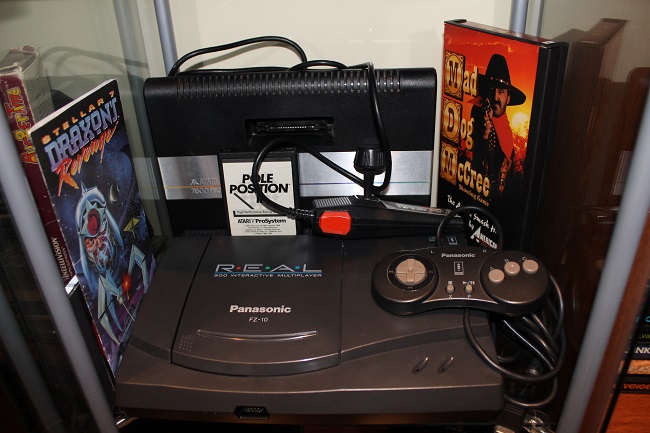
The 3DO (bottom) design ushered in a range of games containing FMV (full motion video) sequences, due to the move to CD-ROM media. The 7800 was Atari's answer to the popular NES, but didn't have a beefy enough game library to compete.
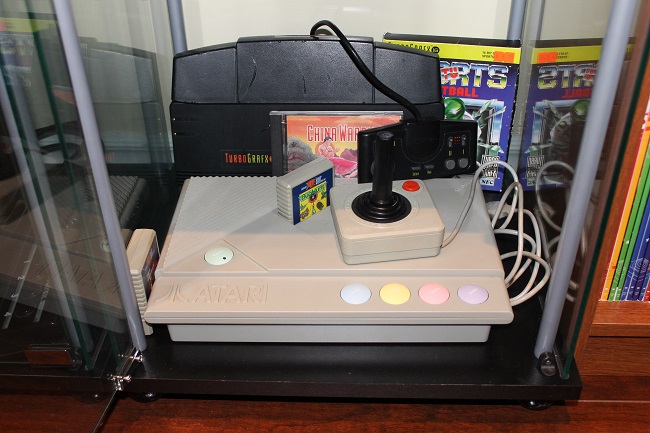
The XEGS (bottom) is a "consolification" of the Atari 65XE 8-bit computer, made to look futuristic, with the slanted cartridge and joystick connectors (rather than aligned) and bright round buttons.
NEC's TurboGrafx-16 has accumulated a solid library of beautiful arcade ports and was very successful in Japan.

Here we have the first three games of the Mario Party franchise, on Nintendo 64, complete in box.
At the top, the PocketStation is a PlayStation memory card with a LCD screen and buttons slapped on, turning it into a mini-hand held console. The more you played it, the better power-ups you got in regular PlayStation games.
The Coleco Telstar is an early Pong console. Its build is of very low quality; the plastic shell feels light and hollow, and the faux wood panel is a thin sticker.

The Odyssey 2 is the successor to the world's first video game console, Odyssey.
The Power Glove was an early Nintendo gesture-based controller which failed because of its poor accuracy.


These were sold as a step up from hand held LCD games and featured lit screens and nice artwork on the case. They were marketed as "arcade games on your table".

Various PC games, spanning multiple genres and generations.
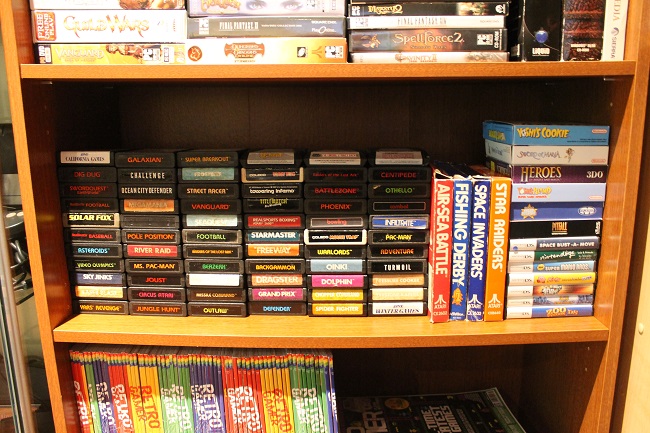
A few nice stacks of Atari 2600 cartridges to the left, and Gameboy Advance/Nintendo DS cartridges to the right

The British Retro Gamer magazine is the best retro gaming publication. Some of my homebrew were featured in their Homebrew section.

At the top right we have a LCD game which simulates a tank's periscope.
To the left, we have some Neo Geo Pocket Color games, some unboxed PC games, and a few PlayStation 1 games.
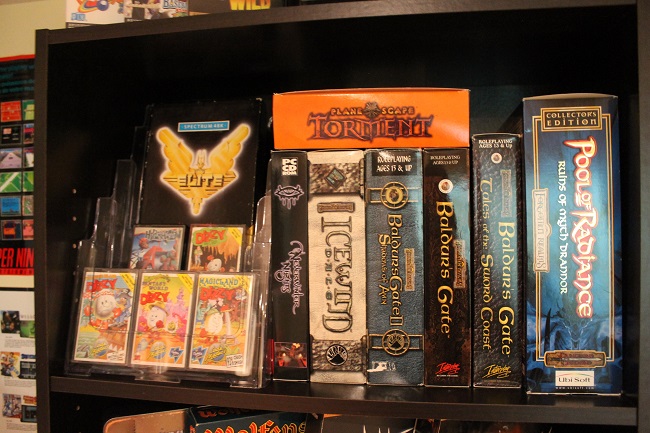
The cassette tapes to the left are ZX Spectrum games. We have Hyperaction (first video game I ever played), Elite (a great space flight/trading simulator), and four Dizzy games (puzzle/adventure starring an egg taking on quests ranging from escaping from dungeons to removing Excalibur from the stone).
The large PC game boxes on the right are Dungeons&Dragons-based RPGs, including the highly successful Baldur's Gate 2.

The Wolfenstein series started the 3d shooting genre in 1992 with Wolfenstein 3d, and continues to date.
In contrast to the gun blazing Wolfenstein games, Thief games rely primarily on stealth and planning, as the protagonist is not adept at hand-to-hand combat. They mesh beautifully elements of steampunk, supernatural, and create a dark, foreboding atmosphere.

Intellivision decided to colour code their game boxes, allowing for colourful arrangements like I have here. To the right we have the Balls of Steel edition of Duke Nukem Forever for PC.
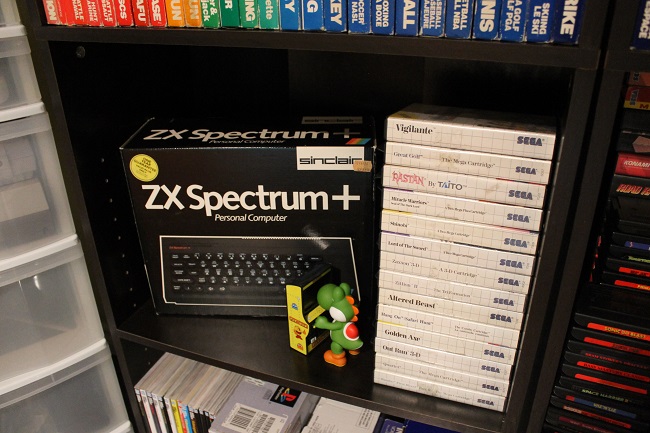
The ZX Spectrum+ was the first gaming platform available in my house. It hooks up to a TV and loads from cassette tapes, which are prone to failure. Spectrums were very widespread in Romania, due to their low cost. Additionally, using exclusively off-the-shelf components, meant that they were easily counterfeited.
Also in this section: a stack of Sega Master System cartridges.
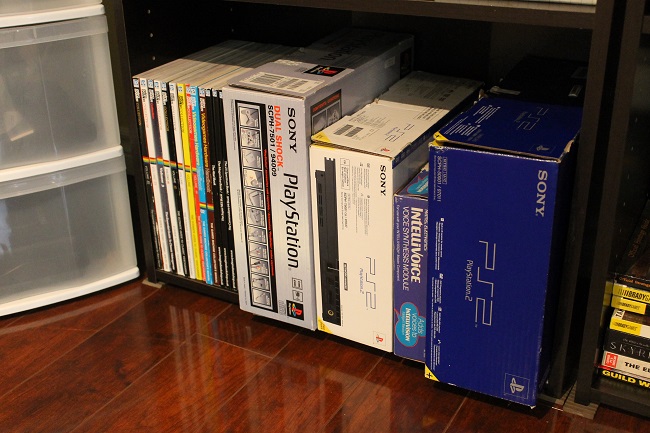
A small collection of Retro Gamer "bookazines".
The small box holds the Intellivoice, a hardware add-on which added voice synthesis (considered cutting-edge technology in the early 1980s) to select Intellivision games.
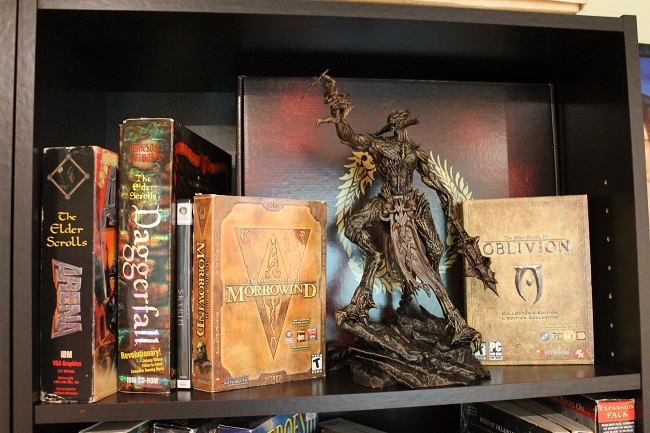
All 5 PC Elder Scrolls games (Arena, Daggerfall, Morrowind, Oblivion, Skyrim) plus the MMO Elder Scrolls Online (collector's edition). These games (aside from the MMO) have offered some of the finest single player RPG open world game play over the years. Morrowind represents my introduction to this series, in 2002.
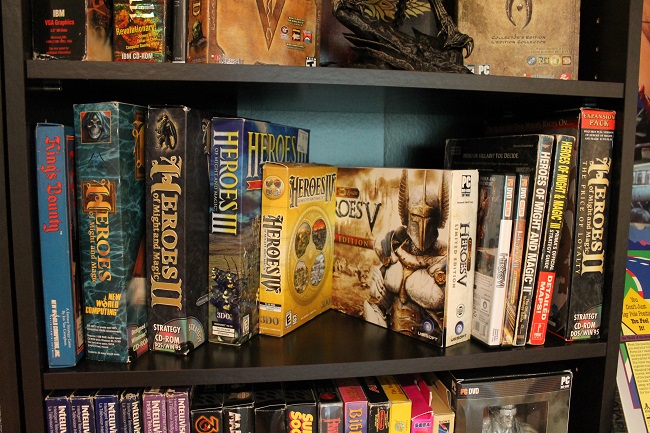
All 7 Heroes of Might and Magic PC games, plus the Price of Loyalty expansion for Heroes 2. This turn-based fantasy strategy series has enjoyed great success in Europe. The second game is my favourite, but I like to play the first and third, as well.
The left-most box is King's Bounty, which is the predecessor of the Heroes of Might and Magic series.
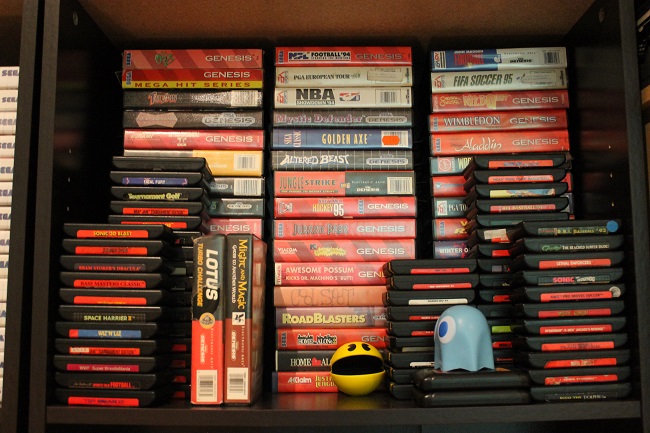
A pile of Sega Genesis (called Megadrive in Europe) games. Sega Genesis game cases were made of plastic, preserving them much better than, say, Super Nintendo cardboard game boxes.
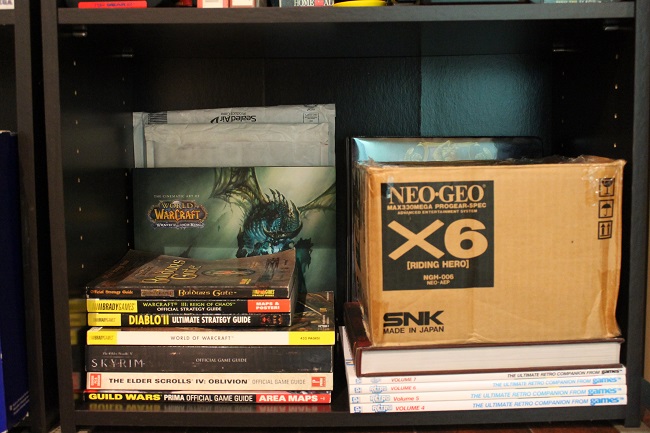
This area contains game guides, gaming bookazines, art books, and a box full of video game manuals and booklets. The brown box is a Neo Geo cartridge shipping box.

A good looking poster to a bad movie. The movie Street Fighter was memorably bad. You realize it's bad when the protagonist, who's supposed to be overly American, is played by an actor with a French accent. However, it's a pass in my book, because it's about Street Fighter.
The yellow console at the top is the Odyssey 300, basically a state of the art Pong machine.
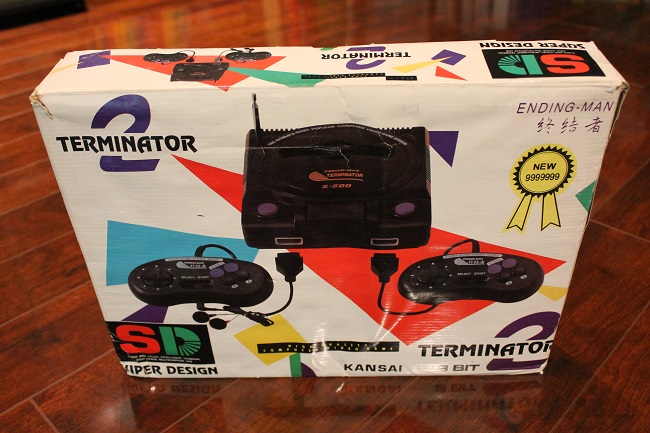
This console is one of many fake Nintendos sold in Romania. The term "famiclone" comes from Famicom (the name of the Nintendo console in Japan) and the term "clone" for counterfeit consoles.
Due to the low prices of famiclones and their games (usually yellow cartridges the size of Japanese Nintendo cartridges), I did some of my gaming on one such system.
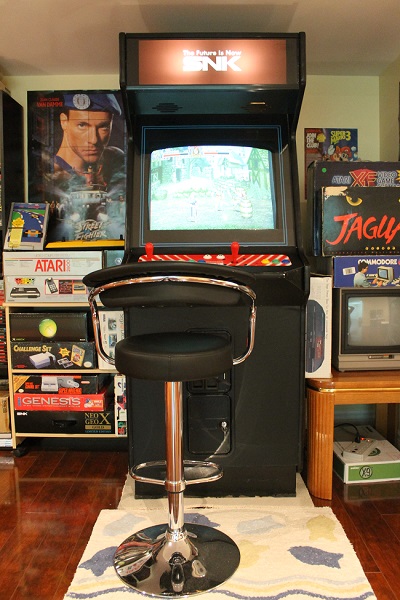
This arcade machine is a Dynamo-brand cabinet. The control panel configuration (4 buttons) makes it great for Neo Geo games. Inside, I have a single-slot MVH Neo Geo arcade mother board (which plays Neo Geo MVS cartridges), as well as a Blue Elf 309-in-1 multi game cartridge.
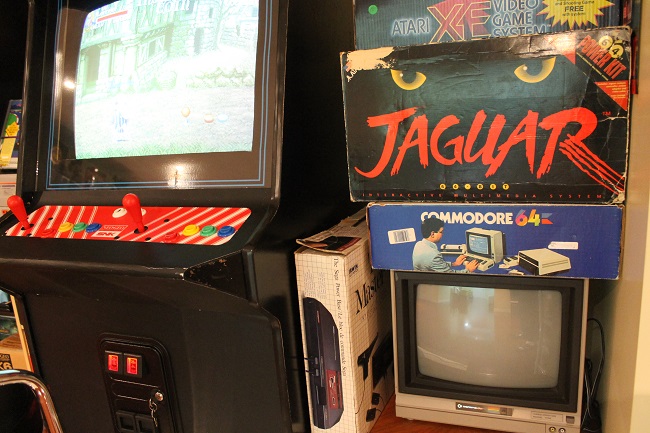
These monitors output a very sharp picture due to good pixel density and possibly due to simpler circuitry than a regular TV. Even games on consoles more modern (non-HD) than the Commodore 64 will look beautiful on these monitors.
Also in this photo we have a Sega Master System, the first Sega system to be introduced in the West.
I hope you enjoyed seeing some of these games, and possibly remembering playing them yourself.

I did not build this collection single-handedly; benevolent contributors include friends and co-workers.
Favourite game - Knights of the Round (arcade board)


Knights of the Round is my favourite game of all time. I invested great amounts of time and money in the local arcade playing it, and I have many fond memories of it. Obtaining the original arcade board for my collection was a no-brainer. It is a classic arcade beat'em up set in Arthurian Britain.
I like this game so much, that I've written what some call a very in-depth review of it here. My review covers so many aspects (technical, gameplay, ports, exploits, etc.), that some called it a dissertation!

First ever game played - Hyperaction (on ZX Spectrum)


Hyperaction was the first video game I ever played, at around 4 years old, on a ZX Spectrum+ computer. I played it because my parents and uncle played it. Its difficulty would often frustrate me as a child. It's a single-screen puzzle game where you must collect all items while avoiding enemies, and then reach a "goal" square.
As with most ZX Spectrum games, it was distributed on a regular cassette tape. It took about 4 minutes to load from a cassette player.
First PC game ever played - Prince of Persia (on IBM PC)


Here are Prince of Persia 1 and 2 for DOS. Prince of Persia 1 is the first game I played on the PC, having access to it on a computer at my father's work, in the early 90s. The life-like animation, dungeon and castle graphics, cinematic game play and story telling made this a master piece.
The book is a print publication of excerpts of Jordan Mechner's (the creator of the series) personal diary. It describes the creation of the first game, including struggles with red tape, financial negotiations, keeping up the sponsors' faith in the project, etc.

The second Prince of Persia came a few years later, taking up a hefty four floppy disks (about 12 times larger the original). Prince of Persia 2 had significantly improved visuals, with parts of the game taking place in caves, castle ruins, temples, etc. The difficulty was also cranked up.
First collection item - Gameboy

This is the first building block of my collection. It's how it all began. I bought it for between $10 and $15 in 2001.
Blizzard collection

I focus on Blizzard's "big three" game series, Warcraft, Diablo, Starcraft. Collector's Editions are preferred over standard editions. Blizzard is known for its very high quality video games, which is probably why they've kept me as a faithful follower all these years.
The Starcraft section is on the left, the Warcraft games are in the centre, and to the right are the Diablo games.

I was over at a classmate's, and he showed me Warcraft 1: Orcs and Humans. Seeing the little soldiers attack a building in unison (which later burns down and is destroyed), was awe-inspiring.
Since then, I continued to follow the Warcraft series of games.
The orc grunt action figure at the top left was sold when Warcraft 1 was current (1994), and the boxed World of Warcraft orc wolf rider statue in the centre was sent out in 2015 as a surprise to subscribers who had active accounts for throughout all 10 years from World of Warcraft's release.
It also coincided with the 20 year celebration of the Warcraft franchise.

Similarly, I've stuck with the Diablo series because of how impressive dungeon and item randomization was to me when I first played Diablo 1.

I played the Starcraft games the least, but I have great memories of playing it against my friends at early Internet Cafes in Bucharest.
Neo Geo AES games

The Neo Geo was mostly known as an arcade platform, offering games such as King of Fighters, Samurai Shodown, Fatal Fury, World Heroes, Metal Slug, etc. I played these in an arcade in downtown Bucharest. Later, I discovered the Neo Geo AES, the home console which contained arcade hardware. This meant that it enabled 100% arcade-faithful game play in the home, unfortunately at a very high cost.
Noteworthy games in this collection are Metal Slug 4, and the complete King of Fighters series (10 games, released in 1994 through 2003).

Super Nintendo games

While the Neo Geo AES is my favourite home console, the Super Nintendo is undoubtedly the richest in games and genres. Along with the Neo Geo, I consider these games to be the highest quality two-dimensional (pre-3d) games ever produced.
Role playing games shine brightest on the Super Nintendo, which is why I like to collect them complete (with box, manuals, maps, etc.)
Nintendo games and Gameboy Pokemons

The Nintendo Entertainment System was a highly influential platform, which reversed the video game crash of the 1980s caused by gross disregard to quality by major players such as Atari. It is home to the start of successful franchises such as Super Mario Brothers, Zelda, Metroid, Mega Man, etc.
The Pokemon series began with these three titles (Pokemon Red, Yellow, and Blue) and went on to become an international phenomenon. Its creator collected insects as a hobby, which inspired the series.
I liked and bought the complete in box Zelda cartridge because of its historical importance and its nice gold colour. Gold is best.
Nintendo Power and Neo Geo MVS games

Nintendo Power magazine was the best source of video game information available in the 80s and 90s, due to the general absence of the Internet.
To the right, there is a stack of large Neo Geo MVS cartridges. These were used in Neo Geo arcade machines, especially the multi-game versions, which allowed the player to choose between multiple games. My first contact with Neo Geo games was in a large arcade in downtown Bucharest, where I played primarily King of Fighters 94.
The other cartridges here are for a variety of systems including Nintendo 64, Odyssey 2, Nokia Ngage, etc.
Nintendo hand helds

These hand helds here start with the Game and Watch LCD games of the 80s and go all the way to the 3DS/2DS platforms, Nintendo has been the dominant player in the hand held market despite fierce competition from Sega, Atari, Sony.
The Game and Watch LCD game here is Mario's Cement Factory, which a friend showed to me back in Romania. Nintendo LCD games were more feature-rich than abundant no-name LCD games from the early 90s.
Other hand helds

Here we have Sega Nomad, which plays full-size Sega Genesis cartridges, the controversial Neo Geo X, the WonderSwan, and the Neo Geo Pocket Color. To the right is a Sony PSP.
Sega Saturn and Sega Dreamcast

Sega's last two home systems. The Saturn was very popular in Japan, while the Dreamcast enjoyed success all over the world. The Dreamcast was home to many high-quality arcade games.
Capcom CPS2 arcade board

This huge green thing is actually two boards: the black motherboard at the bottom, and the green game "cartridge" on top. The game here is Street Fighter Zero 2, the Japanese version. These CPS2 boards were used in arcade machines of mid 90s to early 2000s. I used to play a similar CPS2 game, X-Men vs. Street Fighter at a pool hall which had arcade games in its basement, in Bucharest.
The SNES game cartridge is shown for size comparison.

Neo Geo AES console

An elite console which brought arcade-perfect games (in a time when home games were much lower quality) into homes for the first time ever. A single game cartridge cost as much as a competitor's console. The Neo Geo AES was never meant to be mainstream; it targeted a niche segment of hardcore gamers with deep pockets.
The game is Neo Thunder, which I programmed myself.
The controller shown here is the arcade-style controller, which has a joystick and buttons arranged the same as the arcade machine.
It's noteworthy to mention that the Neo Geo AES was the first console to ever use memory cards. Game progress could be loaded and saved interchangeably between AES home systems and MVS arcade systems.
Nintendo Virtual Boy and others

The Virtual Boy uses two displays, one for each eye, to successfully give the impression of 3d. It was Nintendo's biggest failure, causing headaches shortly after starting game play, and forcing
Nintendo to cover the manual in red-text health warning sections.
To the left there is the Sega 32x, meant to prolong Sega Genesis/Megadrive's life. To the right is the first ever colour hand held system, the Atari Lynx.
Mattel Intellivision and Coleco Gemini

The Intellivision (complete with awesomely tasteless faux wood panels) was born out of Mattel's desire to benefit from the booming video game market.
The Gemini is an Atari 2600 clone created by Coleco. It is interesting because Coleco also created
the ColecoVision, meant to compete with the Atari 2600. In today's terms, this is analogous to Sony not only creating the PlayStation, but also creating an Xbox clone.
Vectrex

This system not only incorporated its own display, but was also vector-based rather than raster based. All graphics it output were made of (theoretically) infinite resolution lines. This made game play feel very smooth compared to traditional raster-based consoles.
Atari 2600 and Atari Jaguar

Atari's alpha and omega, their first and last home consoles. The 2600 (top) was responsible for both a video game market boom and crash. The game to the right is Snappy, which I programmed myself.
The Jaguar was a technically-complex system which tried to "sell by numbers", touting its 64-bit architecture. Unfortunately, it quickly lost to the 16-bit systems of the time.
Panasonic 3DO and Atari 7800

The 3DO (bottom) design ushered in a range of games containing FMV (full motion video) sequences, due to the move to CD-ROM media. The 7800 was Atari's answer to the popular NES, but didn't have a beefy enough game library to compete.
Atari XEGS and TurboGrafx-16

The XEGS (bottom) is a "consolification" of the Atari 65XE 8-bit computer, made to look futuristic, with the slanted cartridge and joystick connectors (rather than aligned) and bright round buttons.
NEC's TurboGrafx-16 has accumulated a solid library of beautiful arcade ports and was very successful in Japan.
Mario Parties and Pong machine

Here we have the first three games of the Mario Party franchise, on Nintendo 64, complete in box.
At the top, the PocketStation is a PlayStation memory card with a LCD screen and buttons slapped on, turning it into a mini-hand held console. The more you played it, the better power-ups you got in regular PlayStation games.
The Coleco Telstar is an early Pong console. Its build is of very low quality; the plastic shell feels light and hollow, and the faux wood panel is a thin sticker.
Odyssey 2 and Power Glove

The Odyssey 2 is the successor to the world's first video game console, Odyssey.
The Power Glove was an early Nintendo gesture-based controller which failed because of its poor accuracy.
Various consoles

Donkey Kong tabletop game

These were sold as a step up from hand held LCD games and featured lit screens and nice artwork on the case. They were marketed as "arcade games on your table".
PC games

Various PC games, spanning multiple genres and generations.
Atari 2600 games

A few nice stacks of Atari 2600 cartridges to the left, and Gameboy Advance/Nintendo DS cartridges to the right
Retro Gamer magazines

The British Retro Gamer magazine is the best retro gaming publication. Some of my homebrew were featured in their Homebrew section.
Weird tank LCD game and others

At the top right we have a LCD game which simulates a tank's periscope.
To the left, we have some Neo Geo Pocket Color games, some unboxed PC games, and a few PlayStation 1 games.
ZX Spectrum games and PC RPGs

The cassette tapes to the left are ZX Spectrum games. We have Hyperaction (first video game I ever played), Elite (a great space flight/trading simulator), and four Dizzy games (puzzle/adventure starring an egg taking on quests ranging from escaping from dungeons to removing Excalibur from the stone).
The large PC game boxes on the right are Dungeons&Dragons-based RPGs, including the highly successful Baldur's Gate 2.
More PC games

The Wolfenstein series started the 3d shooting genre in 1992 with Wolfenstein 3d, and continues to date.
In contrast to the gun blazing Wolfenstein games, Thief games rely primarily on stealth and planning, as the protagonist is not adept at hand-to-hand combat. They mesh beautifully elements of steampunk, supernatural, and create a dark, foreboding atmosphere.
Intellivision games

Intellivision decided to colour code their game boxes, allowing for colourful arrangements like I have here. To the right we have the Balls of Steel edition of Duke Nukem Forever for PC.
ZX Spectrum+ computer

The ZX Spectrum+ was the first gaming platform available in my house. It hooks up to a TV and loads from cassette tapes, which are prone to failure. Spectrums were very widespread in Romania, due to their low cost. Additionally, using exclusively off-the-shelf components, meant that they were easily counterfeited.
Also in this section: a stack of Sega Master System cartridges.
More various consoles

A small collection of Retro Gamer "bookazines".
The small box holds the Intellivoice, a hardware add-on which added voice synthesis (considered cutting-edge technology in the early 1980s) to select Intellivision games.
Elder Scrolls collection

All 5 PC Elder Scrolls games (Arena, Daggerfall, Morrowind, Oblivion, Skyrim) plus the MMO Elder Scrolls Online (collector's edition). These games (aside from the MMO) have offered some of the finest single player RPG open world game play over the years. Morrowind represents my introduction to this series, in 2002.
Heroes of Might and Magic collection

All 7 Heroes of Might and Magic PC games, plus the Price of Loyalty expansion for Heroes 2. This turn-based fantasy strategy series has enjoyed great success in Europe. The second game is my favourite, but I like to play the first and third, as well.
The left-most box is King's Bounty, which is the predecessor of the Heroes of Might and Magic series.
Sega Genesis games

A pile of Sega Genesis (called Megadrive in Europe) games. Sega Genesis game cases were made of plastic, preserving them much better than, say, Super Nintendo cardboard game boxes.
Various printed materials

This area contains game guides, gaming bookazines, art books, and a box full of video game manuals and booklets. The brown box is a Neo Geo cartridge shipping box.
Poster and even more various consoles

A good looking poster to a bad movie. The movie Street Fighter was memorably bad. You realize it's bad when the protagonist, who's supposed to be overly American, is played by an actor with a French accent. However, it's a pass in my book, because it's about Street Fighter.
The yellow console at the top is the Odyssey 300, basically a state of the art Pong machine.
Terminator "Ending Man" famiclone

This console is one of many fake Nintendos sold in Romania. The term "famiclone" comes from Famicom (the name of the Nintendo console in Japan) and the term "clone" for counterfeit consoles.
Due to the low prices of famiclones and their games (usually yellow cartridges the size of Japanese Nintendo cartridges), I did some of my gaming on one such system.
Arcade machine

This arcade machine is a Dynamo-brand cabinet. The control panel configuration (4 buttons) makes it great for Neo Geo games. Inside, I have a single-slot MVH Neo Geo arcade mother board (which plays Neo Geo MVS cartridges), as well as a Blue Elf 309-in-1 multi game cartridge.
Commodore 64 monitor

These monitors output a very sharp picture due to good pixel density and possibly due to simpler circuitry than a regular TV. Even games on consoles more modern (non-HD) than the Commodore 64 will look beautiful on these monitors.
Also in this photo we have a Sega Master System, the first Sega system to be introduced in the West.
I hope you enjoyed seeing some of these games, and possibly remembering playing them yourself.